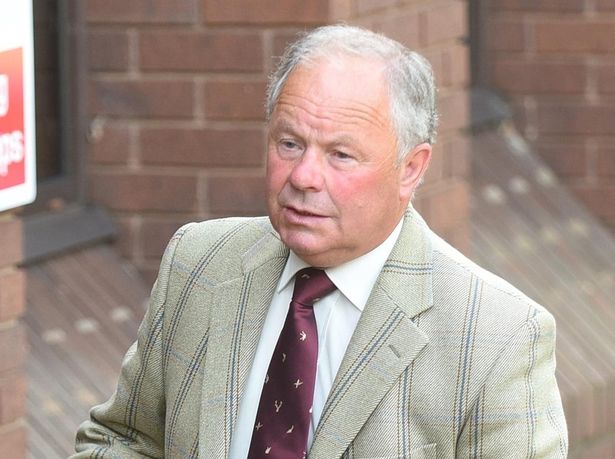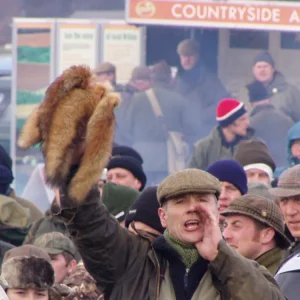
The Fitzwilliam huntsman who was in charge of a pack of dogs which killed a fox has been fined after being convicted of breaching hunting laws.
Retired huntsman George Adams (66) was convicted of using hounds to kill the fox on January 1 2016.
Falconer John Mease was found not guilty of the charge, and also not guilty of causing unnecessary cruelty to an animal relating to the hunting of a fox in 2013.
The two men appeared at Peterborough Magistrates Court during a two day trial.
District Judge John Woollard said he had heard no evidence the hunt had made any changes to their activities – other than using the falconer since the hunting act was brought in in 2005.
The packed court – with the public gallery filled with supporters of the hunt and hunt saboteurs – heard from saboteurs Ruth Nichols and Stephen Milton, who had tracked the hunt on New Year’s Day. Video footage shown to the court taken by Mr Milton on the day showed the hunt, which involved around 40 hounds – with the sound of a hunting horn clearly heard.
The hunt was taking place in fields near Wansford at about 1.30pm when the hounds were seen to get the scent of the fox. Mr Milton said he had seen the hunt tracking the fox, and had not heard any calls to call the dogs off from the fox from the hunt.
Miss Nichols also said she had not heard calls to slow the hounds down during the hunt. However, Mr Milton said while members of the group of saboteurs he was with did not have their own hunting horn, it was possible other saboteurs did have one.
Video footage taken from a headcam worn by Mr Mease was shown to the court, and he could be heard saying the fox would have escaped had the groups of saboteurs not been blocking its escape route – something denied by both Mr Milton and Miss Nichols.
Professor Stephen Harris told the court hunts would regularly use packs of dogs with up to 40 dogs in before the hunting ban was implemented, but hunts using birds of prey in the past would only use two or three to catch the fox.
He also said: “Dogs can be trained not to catch certain animals – the fox hounds here do not go chasing after sheep, which is their natural prey.
“In the footage there is also no-one from the hunt who is telling the dogs they have done wrong when they had killed the fox.”
Adams, who joined the Fitzwilliam Hunt in 1981 and became a huntsman in 1984, told the court he had not seen the fox before it was killed. When asked if it was his intention to kill the fox with hounds, he said: “Absolutely not. We wanted to flush it out for the bird of prey.”
Mr Mease told the court there was no chance for him to release his golden eagle to catch the fox because the saboteurs were in the field, which would provide a risk to the bird. He was asked why he never radioed Adams to call the hunt off. He said: “A hunt is a fluid thing.
“It was changing minute by minute
“It was the heat of the moment and it was the first time I had come across saboteurs in my 11 years.”
He told the court he was in charge of the bird – but had no control over the pack of hounds, which was Adams’ responsibility. It was suggested the hunt could have used other breeds of dog, such as spaniels and pointers, to flush out the fox, which could have been trained not to kill the animal – and fewer dogs would have been needed.
The court heard from George Bowyer, who was joint master of the Fitzwilliam Hunt when the Hunting Act was introduced. He said the hunt had decided to use a bird of prey as it was allowed under the legislation, and there was no limit to the amount of dogs that could be used.
He said: “We wanted to keep the hunt running, within the law, as close as we could to before the act was introduced so we could keep the blood line of the hounds going for when the Hunting Act was repealed.”
He added that fox hounds could be trained to stop, and there were ‘whippers in’ on hunts to keep the dogs in check during hunts.
Mr Bowyer told the court the hunt had spent a lot of time and money with lawyers examining the law when it was introduced, and making sure the hunt stayed within the law.
Prosecutor Joe Bird labelled Mr Mease and his eagle as a ‘smokescreen’ used by the hunt to allow it to continue as it had before the ban.
He said: “The set up was never going to work. It was a smokescreen.
“There were so many occasions when they would not have been able to fly the eagle.”
But Stephen Welford, defending both men said: “There is video footage of Mease using his eagle to kill a fox. That would not exist if it was a smokescreen.”
When Adams was found guilty, the court was told the only sentence that could be passed by law was a fine. Adams was fined £1,000 and ordered to pay a £100 victim surcharge and £930 costs. Mr Mease was cleared after Judge Woollard said it was clear he had no control over the hounds during the hunt.
Speaking outside court following the verdict, Adrian Simpson from the Countryside Alliance said they believed the judge had made the wrong decision, and Adams was planning to appeal against the verdict.
On Tuesday the court was shown headcam footage from Mr Mease regarding the death of the fox in 2013. He used his golden eagle to catch the mammal, before using a falconers knife – a pointed blade – to ‘dispatch’ the fox by driving the spike through the animal’s eye.
Mease, who joined the Fitzwilliam Hunt after hunting with dogs was made illegal in 2004, was the only bird of prey handler in the hunt.
He told the court the hunt’s hounds would flush the animal out into the open, when he would use his eagle to catch the animal. Riding a quad-bike, he would then ride up to the bird and the prey – before making sure the fox was killed.
Mease said his number one priority was the safety of the eagle – and his number two priority was the welfare of the fox.
The court was shown a video of the occasion in November 2013 – and told it took 47 seconds to kill the fox from the moment it was caught by the eagle. The court was shown a video of the occasion in November 2013 – and told it took 47 seconds to kill the fox from the moment it was caught by the eagle.
He said the falconers knife was the safest way of ‘dispatching’ a caught fox. He said a kitchen style knife could damage the eagle’s talons, while a ‘captive bolt’ was also dangerous to the eagle.
He said while it would have been better to have killed the fox quicker than 47 seconds after it had been caught, he said: “No-one else could have done it quicker.”
He was also accused of hunting for sport – but he said: “Not at all. I am employed as a pest controller
“I respect all animals. I don’t get pleasure in dispatching a fox. There is no nice death. This is just how it is.”
Professor Harris told the court that for fox hunting to be used as a successful method of population control, a large number of foxes – up to 80 per cent in an area – would have to be killed, as new foxes move in and take over territory when a fox is killed.
He also said foxes were not pests.
However, Dr Neil Forbes disagreed and said: “If there is a problem fox, it can cause big problems, especially around lambing time. If that fox is killed, it can be a real benefit to a farmer – even for just a few days.”
Judge Woollard cleared Mease of the animal welfare charge, and said: “To the squeamish this way of dispatching foxes seems a bloody and basic way of killing an animal. But I do not find it proved that the act caused the animal unnecessary suffering.”



